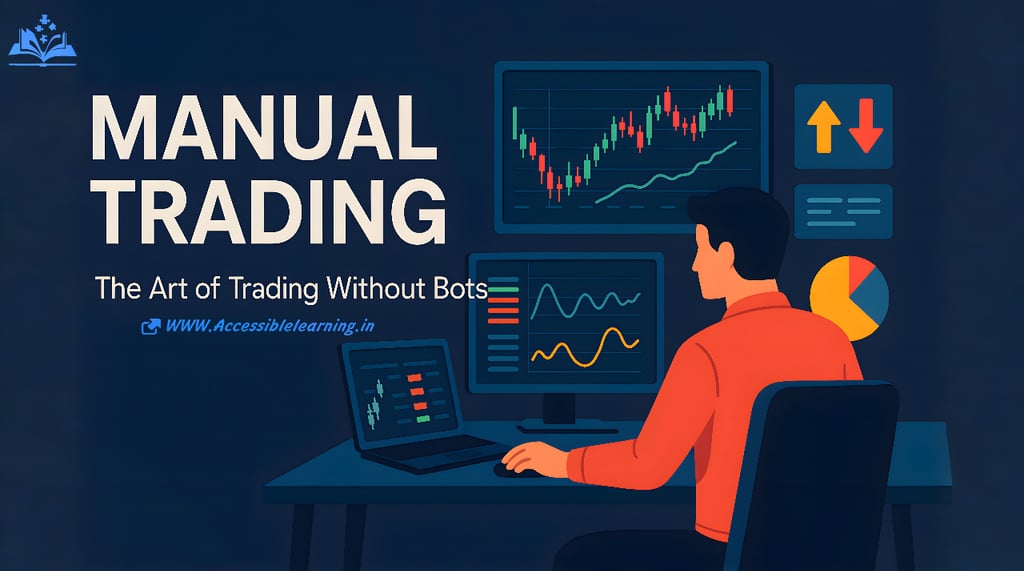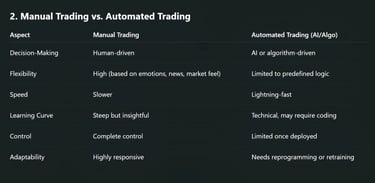
Manual Trading in 2025: A Human-Centered Approach in the Age of AI
Discover the power of manual trading in 2025 — where human intuition meets smart tools. Learn the key skills, tools, and strategies manual traders use to stay profitable in an AI-driven market.
BANKING/CASH-FLOWSTOCK OPERATORSTOCK MARKETEDUCATION/KNOWLEDGE
Sachin K Chaurasiya
6/7/20253 min read


Table of Contents
What is Manual Trading?
Manual Trading vs. Automated Trading
Why Manual Trading Still Matters in 2025
Key Skills Required for Manual Trading
Top Tools That Support Manual Traders (Human + AI Assist)
Final Thoughts: Is Manual Trading Right for You?
What is Manual Trading?
Manual trading is the process where a trader makes their own buy/sell decisions based on real-time market research, chart analysis, and personal judgment. Unlike automated or AI-driven systems that follow preset instructions, manual traders observe market signals and execute trades themselves through a trading platform.
This traditional approach relies heavily on knowledge, focus, and emotional control—often turning trading into both an art and a discipline.


Why Manual Trading Still Matters in 2025
In a market increasingly influenced by AI bots and high-frequency trading, manual trading continues to offer:
Flexibility in Unpredictable Conditions: Humans can pivot in response to news, emotion, or intuition.
Personal Learning Growth: Trading manually cultivates analytical thinking and self-discipline.
Deeper Market Understanding: Manual traders often develop a more refined feel for market rhythms and cycles.
Safety Valve: In high-volatility scenarios, humans can step back, reevaluate, and avoid cascading losses that bots might trigger.
Key Skills Required for Manual Trading
To succeed in manual trading, one needs a multi-dimensional skill set:
Technical Analysis: Mastery of charts, trendlines, candlesticks, and indicators like RSI, MACD, EMA.
Fundamental Awareness: Understanding earnings reports, economic indicators, and political events.
Discipline & Psychology: Staying calm under pressure, avoiding revenge trading, and sticking to plans.
Risk Management: Knowing when to enter, where to set stop-loss, and how much to risk per trade.
Strategic Thinking: Building a solid trading plan, adapting based on performance, and journaling for review.
Top Tools That Support Manual Traders (Human + AI Assist)
Here’s a blended list of powerful platforms and AI-enabled tools that can enhance manual trading while still keeping you in control:
👉 TradingView
Advanced charting with community ideas and AI-generated indicators.
👉 MetaTrader 4 & 5 (MT4/MT5)
Forex & CFD manual trading supports AI plugins but gives full manual control.
👉 Thinkorswim (TD Ameritrade)
Robust U.S. platform with smart AI-based scanning but great for manual decisions.
👉 Finviz
Screener with visual heat maps, technical filters, and basic AI-assisted recommendations.
👉 Bookmap
Visualizes market depth and liquidity, aiding human insight into order flow.
👉 TrendSpider
AI-assisted charting platform that suggests trendlines and patterns—ideal for semi-manual setups.
👉 QuantConnect (for Strategy Backtesting)
Let traders manually backtest ideas, even if they’re not ready for automation.
👉 Koyfin
Powerful for macroeconomic and fundamental analysis with intuitive dashboards.
👉 Sentiment.io
AI-based sentiment analysis platform that tracks crowd emotions and news impact.
👉 Edgewonk
AI-driven trading journal that analyzes your trades and offers personalized insights.
👉 Investing.com & ForexFactory
Global economic calendars and breaking news for informed manual trade entries.
👉 AlphaSense
AI-based research tool that scans earnings calls, filings, and market chatter—great for manual long-term investors.
Manual trading, in the modern sense, doesn’t mean going entirely tech-free. It means you make the decisions while using smart tools to inform those choices. In an AI-dominated world, traders who understand human emotion, risk, and real-time judgment can still outperform rigid bots—especially in volatile or unpredictable markets.
Whether you're a scalper reacting to every candle or a swing trader watching weekly trends, manual trading remains a powerful way to grow wealth and wisdom—if approached with patience, tools, and a learning mindset.
FAQs
What is manual trading, and how does it work?
Manual trading is a trading method where humans analyze the market, make decisions, and execute trades themselves, rather than relying on automated bots or algorithms. Traders monitor price movements, use charts, apply indicators, and rely on intuition or strategy to enter or exit positions.
Is manual trading still profitable in 2025?
Yes, manual trading can still be profitable if approached with discipline, proper risk management, and the right tools. While AI dominates many areas, human judgment, especially during volatile or unexpected events, remains valuable and often more adaptable.
What skills are essential for successful manual trading?
Key skills include technical analysis, fundamental analysis, risk management, trading psychology (emotional discipline), patience, and decision-making under pressure. Consistency and ongoing learning also play a big role.
Which tools are best for manual traders today?
Some of the best tools for manual traders in 2025 include TradingView, MetaTrader 5, Thinkorswim, Finviz, TrendSpider, Bookmap, and economic calendars like ForexFactory. Journaling tools like Edgewonk and research platforms like Koyfin are also very useful.
How is manual trading different from automated trading?
Manual trading relies on human control and decision-making, while automated trading uses algorithms or AI to execute trades based on pre-set rules. Manual trading offers flexibility and human insight; automated trading offers speed and efficiency.
Can beginners start with manual trading?
Absolutely. Manual trading is a great way for beginners to learn how markets work. It encourages learning, strategy building, and personal development. Beginners should start with paper trading or demo accounts to practice without risking real money.
What markets can I trade manually?
You can manually trade a wide range of markets, including stocks, forex, commodities, cryptocurrencies, and indices. Most trading platforms support manual trading across multiple asset classes.
Subscribe To Our Newsletter
All © Copyright reserved by Accessible-Learning Hub
| Terms & Conditions
Knowledge is power. Learn with Us. 📚


